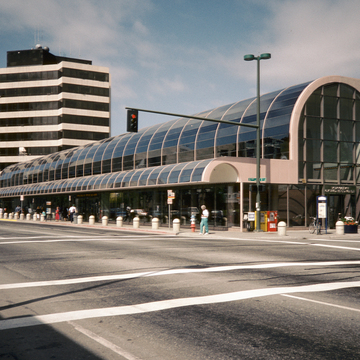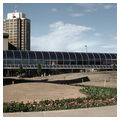Constructed in 1983, the Willam A. Egan Convention Center—named for Alaska's first governor—is a modern design dominated by curved glass. The elongated structure abuts Fifth Avenue and took the place of the old Loussac Library. Its glass-enclosed lobby extends along the street, concealing the windowless block that is most of the building. The Egan Convention Center was built alongside other efforts to modernize the city of Anchorage during the 1980s. Such efforts included the new Loussac Library in Midtown Anchorage, the Alaska Center for the Performing Arts , and the Sullivan Arena. Collectively, this building boom was known as Project 80s.
The Egan Convention Center was designed by Edwin B. Crittenden. Through three decades of practice in and around Anchorage, Crittenden has been among the most well-known architects in Alaska. His firms and partnerships have been known by the following names: Edwin Crittenden, Architects & Associates; Edwin B. Crittenden and Associates; CCC Architects & Planners (Crittenden-Cassetta-Cannon); CCWC (Crittenden-Cassetta-Wirum-Cannon); CCC/HOK (Crittenden-Cassetta-Cannon/Hellmuth-Obata-Kassabaum); and CCWC/HOK (Crittenden-Cassetta-Wirum-Cannon/Hellmuth-Obata-Kassabaum).
Crittenden and his team of architects and planners wanted the Egan Convention Center to serve as a centerpiece of Anchorage's downtown. As such, its enlivened facade has a two-story, round-arch, glass-covered lobby, and for its time was among the most distinct buildings in Alaska. The arch is repeated in the glass canopy extending over the sidewalk. The light-filled lobby, decorated in mauves, with a pink granite floor, contains public art, including a dramatic work of glass beads. There are two levels of windowless meeting rooms in the main block. On the first floor, the 20,000-square-foot Explorers Hall has a 22-foot ceiling height and can be divided into three rooms. On the lower level, the Summit Hall has a 12-foot ceiling height and can be divided into fourteen rooms. A partial mezzanine level at the east end contains administrative offices.
The Egan Convention Center played a vital role in Alaska commerce and functioned as one of the state’s primary business convention venues at a time when the state was undergoing rapid economic expansion and development. However, the Dena’ina Civic and Convention Center, completed in 2008, has taken on much of the role formerly played by the Egan Center. Alongside the Dena’ina Civic and Convention Center and the Alaska Center for the Performing Arts, the Egan Convention Center fills out Anchorage’s dedicated space for trade shows, conventions, concerts, and other civic and cultural events.
References
Edwin B. Crittenden papers, Archives and Special Collections, Consortium Library, University of Alaska Anchorage.




